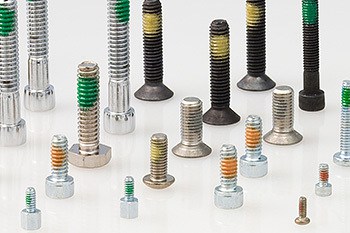ND Patch – Self Locking & Sealing

ND Patch® found its original market in the automotive industry over 40 years ago. This new locking and sealing product quickly expanded into an indispensable service in automotive manufacturing. Currently, ND Patch is a leading fastening technology used, not only in automotive manufacturing, but by a variety of industries in global markets.
A few facts about Patch Technology:
- Patch is one of the leading technologies used to make fasteners self-locking and self-sealing.
- Patch coats an average of 90% of the screws in most PC laptops.
- Patch is regularly utilized on the screws used in bike breaks and gear shifters.
- 95% of the screws in a giant bicycle are coated with patch.
- Most mobile phones use about 20 to 25 fasteners, all of which utilize self-locking coatings like patch.
What is Patch?
Patch is an inert fastener coating that makes threaded fasteners self-locking and self sealing. Patch is not a glue. Patch can be applied to almost any threaded fastener by ND Industries®. This pre-application process means that fasteners come to the assembly line ready to use, no adhesives or other locking devices need to be added. The ND Patch, offered by ND Industries, is an advanced nylon/polymer material dryfused to a fastener at the ND® Processing Plant. ND Patch creates a positive lock upon fastener assembly, preventing loosening and leakage at the fastening point. ND Patch applications replace the need for costly lock washers, cotter pins or castellated nuts. Patch technology has, in some cases, also replaced the use of bottled thread-locking compounds. Because ND Patch is pre-applied before assembly, the use of patch coated fasteners instead of bottled products, which are applied during assembly, improves cost efficiency on long runs.
During ND’s Patch coating process the fastener to which the Patch is being applied is heated to a precise temperature. This heating allows a powdered nylon/polymer material to flow into the shape of the fastener thread. Because the ND Patch coating process entails no drilling or milling, the fastener to which ND Patch is applied does not lose any structural strength. ND Patch is typically applied 2 to 3 threads back from the fastener end for easier starting of the nut/bolt assembly. The ND Patch material fuses to the heated fastener instantly upon application. Since ND Patch is not chemically reactive, no cure time is needed. Once the fastener is cooled, ND Patch coated fasteners are ready for use. This means that ND Patch coated fasteners can be immediately put into automatic assembly preparation equipment, saving precious time in the assembly process.
ND Patch can be applied to almost any internally or externally threaded metallic fastener, whether large construction bolts or tiny screws used in portable electronic devices. Moreover, the nylon-like material used in the ND Patch coating process is highly chemical resistant, and will not dry, shrink, or lose its integrity even when exposed to commercial solvents, alcohol, gasoline, motor oil, caustic soda, jet fuel, anti-freeze, brake fluid, and more.
ND Patch is available in standard coverage, 360° Ring Patch – for extra sealing – and Hi-Temp Patch for assemblies that must withstand temperatures up to 500°F (260°C). Developed by ND Industries for assemblies that operate in extreme heat conditions, such as those used in the aerospace, automotive, appliance industries, and others, ND Hi-Temp Patch performs in temperature extremes ranging from -70ºF to +500º F, exceeding the temperature performance of any other high temperature patch application offered by other companies.
How does ND Patch work?
The ND Patch coating works effectively like a spring and a dam. When a ND Patch coated fastener is threaded onto a mating part, the patch material is compressed. Once a patch coated fastener is engaged, the compression of the patch material that occurs during installation exerts a constant spring-like pressure between the fastener and its mate. This pressure, in turn, creates a strong metal-to-metal lock between the fastener and the mating part on the side of the fastener opposite of the patch. Even if the fastener is not fully seated, the pressure of the ND Patch material forms a positive lock, keeping the fastener in place. Once fully seated, ND Patch coated fasteners are resistant to loosening even when subjected to extreme shock impact and prolonged vibration. This resistance greatly reduces the need to retighten fasteners.
The ND Patch material also works as a dam, virtually eliminating the small spaces between the fastener and its mating part and blocking leak paths along the fastener threads. When the fastener is fully seated, the seal created by ND Patch effectively prevents all fluid leakage.
Even though a superior lock and seal are created by the ND Patch coating on a fastener, the presence of the ND Patch material does not affect fastener adjustability. Unlike many bottled thread locking and sealing adhesives, a fastener coated with ND Patch retains service removability. Furthermore, the ND Patch material does not lose its locking power if the fastener is removed. And, since ND Patch is highly resistant to deformation, patch coated fasteners may be repeatedly reused without compromising their locking ability or damaging their threads.
ND Patch is used in the automotive, construction, medical, electronics, and aerospace industries as well as in military applications and many others.
For more information contact ND Industries at 248-288-0000 or visit www.ndindustries.com.

